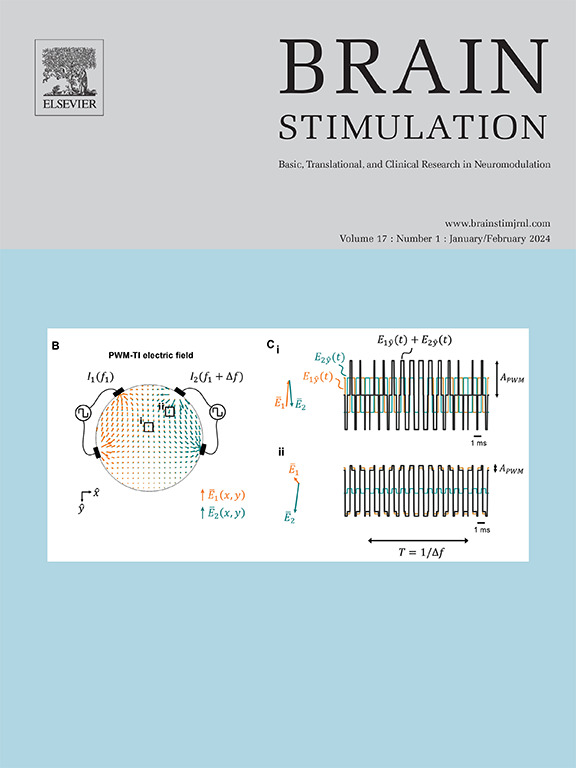小脑皮质抑制是小脑磁刺激对脊髓小脑共济失调3型影响的基础:一项随机对照试验。
IF 8.4
1区 医学
Q1 CLINICAL NEUROLOGY
引用次数: 0
摘要
背景:小脑重复经颅磁刺激(rTMS)已显示出治疗脊髓小脑性共济失调3型(SCA3)的潜力。然而,潜在的电生理机制尚不清楚。在这里,我们的目的是利用单脉冲经颅磁刺激结合脑电图联合登记(TMS- eeg)来探测rTMS对SCA3患者影响的小脑投影。方法:38例SCA3患者和35例健康对照者接受基线TMS-EEG评估小脑投影。使用国际合作性共济失调评定量表(ICARS)对患者进行评估,然后随机接受为期3周的主动间歇性θ波爆发刺激(iTBS)或小脑假iTBS。然后在治疗后和3个月的随访中进行ICARS评估,并在治疗后进行额外的TMS-EEG。结果:iTBS治疗后ICARS评分明显高于Sham刺激(2.67 [95%CI, 0.53-4.81]; p = 0.016)和3个月随访(4.11 [95%CI, 1.02-7.20]; p = 0.011)。iTBS恢复了对侧运动皮层的小脑皮质抑制,这反映在N45振幅增强(1.31 [95%CI, 0.08-2.53]; p = 0.038),这与更好的临床改善相关(p = 0.005)。iTBS还重组了β带振荡,这可能是SCA3个体小脑皮层抑制的基础。在源水平上,小脑rTMS使以运动皮层诱发电流密度为特征的小脑皮层抑制功能受损正常化。结论:我们的研究结果表明,小脑iTBS可能通过恢复小脑皮质抑制和重组β -带活性来减轻SCA3的临床共济失调严重程度。N45振幅可能作为SCA3治疗反应的潜在生物标志物。本文章由计算机程序翻译,如有差异,请以英文原文为准。
Cerebello-cortical inhibition underlies the effects of cerebellar magnetic stimulation on spinocerebellar ataxia type 3: A randomized controlled trial
Background
Repetitive transcranial magnetic stimulation (rTMS) over the cerebellum has shown therapeutic potential for spinocerebellar ataxia type 3 (SCA3). However, the underlying electrophysiological mechanisms remain unclear. Here, we aimed to utilize single-pulse TMS combined with electroencephalography co-registration (TMS-EEG) to probe cerebellar projections underlying the effects of rTMS in SCA3 patients.
Methods
A group of 38 SCA3 patients and 35 healthy controls underwent baseline TMS-EEG to assess cerebellar projections. Patients were evaluated using the International Cooperative Ataxia Rating Scale (ICARS) and then randomized to receive either a 3-week course of active intermittent theta burst stimulation (iTBS) or sham iTBS applied to the cerebellum. ICARS assessments were then performed at post-treatment and 3-month follow-up, with additional TMS-EEG performed post-treatment.
Results
ICARS scores were improved by iTBS treatment than the Sham stimulation at post-treatment (2.67 [95 %CI, 0.53–4.81]; p = 0.016) and 3-month follow-up (4.11 [95 %CI, 1.02–7.20]; p = 0.011). iTBS restored cerebello-cortical inhibition over the contralateral motor cortex as reflected by enhanced N45 amplitude (1.31 [95 %CI, 0.08–2.53]; p = 0.038), which covaried with better clinical improvement (p = 0.005). iTBS also reorganized beta band oscillation, that potentially underlies the cerebello-cortical inhibition in SCA3 individuals. At the source level, cerebellar rTMS normalized the impaired cerebello-cortical inhibition characterized by the evoked current density over the motor cortex.
Conclusions
Our findings indicate that cerebellar iTBS alleviates clinical ataxia severity in SCA3 potentially by restoring cerebello-cortical inhibition and reorganizing beta-band activity. N45 amplitude may serve as a potential biomarker for treatment response in SCA3.
求助全文
通过发布文献求助,成功后即可免费获取论文全文。
去求助
来源期刊

Brain Stimulation
医学-临床神经学
CiteScore
13.10
自引率
9.10%
发文量
256
审稿时长
72 days
期刊介绍:
Brain Stimulation publishes on the entire field of brain stimulation, including noninvasive and invasive techniques and technologies that alter brain function through the use of electrical, magnetic, radiowave, or focally targeted pharmacologic stimulation.
Brain Stimulation aims to be the premier journal for publication of original research in the field of neuromodulation. The journal includes: a) Original articles; b) Short Communications; c) Invited and original reviews; d) Technology and methodological perspectives (reviews of new devices, description of new methods, etc.); and e) Letters to the Editor. Special issues of the journal will be considered based on scientific merit.
 求助内容:
求助内容: 应助结果提醒方式:
应助结果提醒方式:


